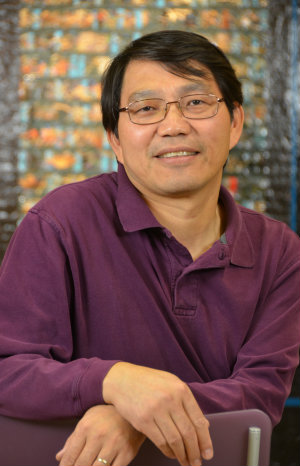Gan Wang
Address
Institute of Environmental Health Sciences, Wayne State University, Scott Hall Room 7205, 540 E Canfield Road, Detroit, MI 48201Office Phone
(313) 577-5583Short Research Introduction
B.S, Microbiology, Shandong University, 1983 Ph.D., Microbiology/Molecular Biology, Chinese Academy of Science, 1989 Postdoc, University of Connecticut (1989-1993) Postdoc, Yale Medical School (1993-1996)Research Interests
One research interest of Dr. Wang's lab is to study DNA damage-induced cellular responses (e.g. DNA repair, cell cycle arrest, apoptosis) and its implication in cancer treatment and cancer drug resistance. His lab also is interested in discovery and development of natural compounds for treatment of cancer and other diseases. One of his most recent research interests is focused on identifying novel compounds from medicinal fungus Ganoderma lucidum and used as novel immunoregulators/immunosuppressors for treatment of cancer and other immune-related diseases.
Department
Institute of Environmental Health SciencesSelected Publications
Wang G, Wang L, Zhou J-L, Xu X. The possible role of PD-1 protein in Ganoderma lucidum-mediated immunomodulation and cancer treatment. Integr Cancer Ther. 2019. 18:1534735419880275. doi: 10.1177/1534735419880275.
Wang G, Bhoopalan V, Wang D, Wang L, and Xu XS. The effect of caffeine on cisplatin-induced apoptosis of lung cancer cells. Experimental Hematology & Oncology 2015. 4:5. PMID: 25937999.
Wang G, Wang X, Xu X. Triptolide potentiates lung cancer cells to cisplatin-induced apoptosis by selectively inhibiting NER activity. Biomarker Res. 2015. 3:17. PMID: 26161259.
Wang G, Wang L, Bhoopalan V, Xi Y, Bhalla DK, Wang D, Xu XS. The role of XPC protein deficiency in tobacco smoke-induced DNA hypermethylation of tumor suppressor genes. Open Journal of Genetics, 2013, 3, 285-293. (http://dx.doi.org/ 10.4236/ojgen.2013.34032).
Colton SL, Xu XS, Wang YA, and Wang G. 2006. The involvement of ATM activation in nucleotide excision repair-facilitated cell survival with cisplatin treatment. J. Biol. Chem.,281:27117-27125.
